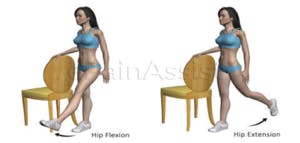As athletes, it is always important to be able to self-assess our body's ability to perform at high intensity levels. Just as our cars feature alert systems such as "check engine", "low tire pressure", etc. our body's need to be able to do the same to assure that we are safe, and most efficient through our activity. Take football for instance, an athlete competing in this capacity not only requires great power and drive through their lower quarter, but also adequate joint mobility and muscle length. I'll explain, as a lineman gets into their stance he is shortening the hip flexor and hamstring muscles. It is in this shortened position that muscle energy is stored. As the ball is snapped the lineman must explode out of that muscle shortened position and now lengthen those very same muscle to generate utmost power. Now, consider if one of those mobility systems was compromised. If the hip flexor or hamstring muscles were too tight, or the hip joint was restricted in its range of motion, that athlete would not be able to explode off the line with the same degree of power. It is an unlikely scenario in this case that they are going to do a good job getting to, or protecting the quarterback. This is just one scenario. Take any position on the field however and you can make the very same argument.
So, what can we do to self-assess? How can we find these problems before they lead to inefficiencies on the field, or worse, injury? This article will go over a few quick assessments that will give you a good idea as to whether you are firing on all cylinders.
The overhead deep squat is a great self-assessment tool because it is easy to perform and assesses limitations of the upper quarter, lower quarter, and trunk. The goal of this test is to squat low with your butt below your knees while maintaining your arms behind the line of your toes. If you find that you are unable to do this, try these 3 modifications to find out what the limiting factor is.
- Hands clasped behind your neck helps to take a tight latissimus (lat) muscle out of the equation. If you are better able to perform your deep squat in this position, the most likely limiting factor is tightness of your lats.
- Heels elevated with a lift will help to shorten the calf muscles and give more room for the ankle joints to work. If you are better able to perform this test, the most likely limiting factor is restrictions at the ankle joint.
- rms crossed is the final modification to this test. If still unable to complete a full squat here, well we have a lot to work on. This test will note limitations of the hips and trunk.


The hip swing test is another self-assessment that we can use to look more closely into our hips and pelvis. Stand with one hand touching onto a support surface. Proceed to swing a straight leg forward and backward like a pendulum. During this test you are encouraged to explore your full range of motion. Indications that your Range of motion is limited are:
- Asymmetric movements on one side compared to the other.
- Slumping of your pelvis when kicking forward may be indicative of tight hamstrings.
- otation of the pelvis when kicking backward may be indicative of hip flexor muscle tightness and joint capsule limitations.

Identifying such limitations early on can be pivotal in improving performance and reducing the risk of injury. It is very important for every athlete to be surrounded by a good team. This is not only the case on the field, but off the field, and in the training room as well. In addressing the self-assessments that we looked at through this article, an athlete may find a physical therapist to be most helpful in improving an athlete's mobility and strength. Following up with a speed and agility coach would be recommended to now apply your bodies now efficient movement patterns into functional, sport specific training.
For any questions or comments regarding the information discussed in this article please feel free to email me at Robert@northislandpt.com. North Island Physical Therapy is located in Stony Brook, NY and uses the methods discussed above to benefit patients of all abilities. For more information about our patient focused clinic go to our website at www.northislandpt.com.


